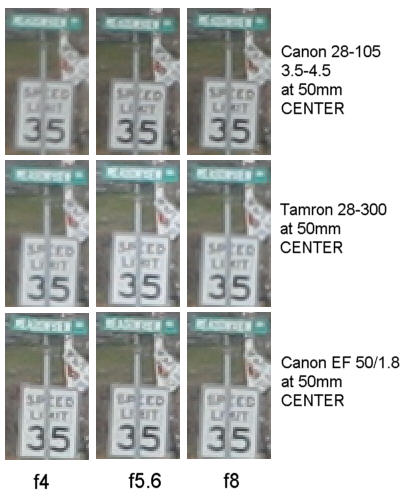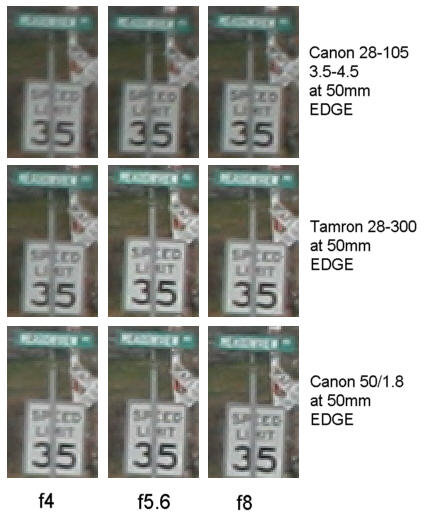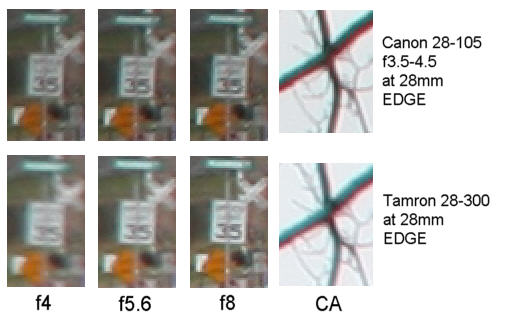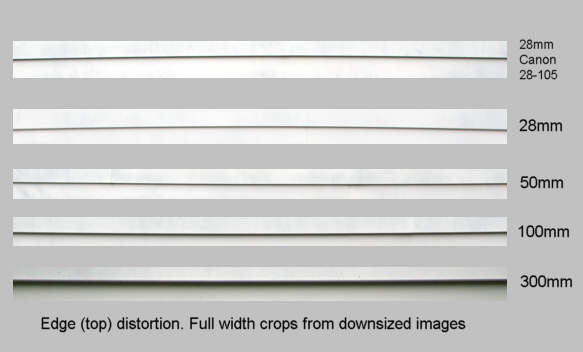
Tamron SP AF28-300/3.5-6.3 XR Di LD Aspherical (IF) Macro Review |
Tamron SP AF28-300/3.5-6.3 XR Di LD Aspherical (IF) Macro Review
50mmComparing the Tamron 28-300/3.5-5.6 with the Canon 28-105/3.5-4.5 and the Canon 50/1.8
In the center of the frame at 50mm, the 50mm prime shows highest image quality at f4, followed by the 28-300 and the 28-105. When stopped down to f8 all three lenses are pretty similar.
At 50mm the edge quality of these three lenses is pretty similar when stopped down. At f4 the Canon 28-105 is a little soft but the Tamron 28-300 is close to the 50mm prime. 28mmComparing the Tamron 28-3003.5-6.3 with the Canon 28-105/3/5-4.5
In the center of the frame at 28mm there's not a lot of difference between these two lenses.
At the edge of the frame at 28mm, the Tamron 28-300 is softer than the Canon 28-105/3.5-4.5. It sharpens up as it's stopped down and by f8 both lenses how similar sharpness. The rightmost frame in the images above shows the chromatic aberration in the corner of the frame. As you can see, both lenses show visible color fringing. The Tamron shows a little more CA than the Canon. DistortionThe crops below are full width crops from the top edge of the frame (image downsized to 500 pixels wide).
As you can see, there is some barrel distortion (lines bow outwards) at 28mm with the Tamron 28-300, though no more than with the Canon 28-105/3/5-4.5. At 50, 100 and 300mm distortion is low, with just a slight touch of pincushion distortion (lines bow very slightly inwards). Overall this is pretty good performance for a wide range zoom. "Macro"At the 300mm setting the 28-300/3.5-6.3 can focus on an object about 10" in front of the lens (about 19" from the sensor or film plane), for a magnification of 2.9:1 (Tamron specs). Here's an example:
As you can see, distortion is very low. Like all close focusing lenses (as opposed to true macro corrected lenses), sharpness does drop off at close focusing distances. Some chromatic aberration is also visible at the frame edges. When operating under these conditions, sharpness is usually maximized by stopping down to f11 or smaller. The above shot was taken at f16 using the built in flash on the EOS 20D. Despite the length of the lens, the flash on the 20D was high enough above the optical axis that the lens barrel did not shade the image ConclusionsIn answer to the original question "Does the Tamron 28-300 deserve respect", I'd have to answer that it does. While I think you could probably do better with two zooms, one covering something like 28-100mm and one covering 100-300mm, not everyone wants to use two lenses. For those who don't, the Tamron 28-300 may be an appropriate choice. For example, the Tamron 28-75/2.8 (which I recently reviewed) is a much sharper lens than the Tamron 28-300/3.5-6.3 (and it's obviously faster too). Both lenses cost about the same (just under $400) and are very close in size and weight. For coverage of 28-75mm it's pretty much a no-brainer as to which lens is the better buy (the Tamron 28-75/2.8, just in case it wasn't obvious...). However, whether the additional 75-300 range is worth the compromises in lens speed and image quality is an individual decision to make. For some people it is, for others it isn't. The bottom line is that if you hate swapping lenses, need one fairly small, light, lens to do everything, and you're prepared to accept some compromises, the Tamron SP AF28-300/3.5-6.3 XR Di LD Aspherical (IF) Macro isn't a bad choice. It also comes with Tamron's standard 6 year warranty too, which is a nice plus. Where to buy?You can look around the rock-bottom discount price places, but be sure to read Caveat Emptor first, so you have at least a fighting chance of not getting ripped off if you shop based on price alone!I'd recommend shopping with Amazon.com, they not only sell directly, but a few reputable stores like Adorama and J&R sell through them too. I've been buying most of my gear through Amazon for the last couple of years and I've had zero problems so far.
© Copyright Bob Atkins All Rights Reserved |
|||





